WENCHENG 文成 RIGHT-DOMINANT DISYLLABIC TONE SANDHI
This page contains examples of disyllabic tone sandhi in a speaker from the county of Wencheng 文成, in the south of the Chinese province of Zhejiang. The speaker is from the county town, also called Wencheng.
The dialects in the Wencheng area belong to the Oujiang 甌江 subgroup of Wu 吳, itself a first-order subgroup of Sinitic. Oujiang varieties are spoken in the south-eastern part of Zhejiang province and Wencheng is in the south-westen part of the Ou area. The sandhi exemplified here is of a type known as right-dominant. Read more about right-dominant sandhi here. You can listen to the tone sandhi and look at the acoustics here, but if you have not yet done so, it might be better to listen to the speaker's isolation tones first, here. Read about the recording here.
RIGHT-DOMINANT TONE SANDHI
Right-dominant, or right-focused is a typological term referring to a kind of tone sandhi common in the sandhi zone of the South-Eastern coastal provinces in China. In right-dominant tone sandhi, it is predominantly the tones on the morphemes on the rightmost syllables of a word or utterance which determine its sandhi shape. The tone on the word-final syllable is said to be preserved, and tonal contrasts on the preceding syllables tend to be neutralised, although not by the spreading typically found in Northern Wu left-dominant systems: the neutralisation groupings are often complicated, and their realisation likewise. These characteristics are things to listen and look for in the Wencheng data below.
The distinction between left- and right- dominant systmes was, I think, first mentioned by Ballard in his 1984 Cahiers de Lingistique Asie Orientale paper: Wu, Min and a Little Hakka – Tone Sandhi: Right and Left. The typological distinction between left- and right-dominant systems is discussed in detail in Jie ZHANG's 2007 J. East Asian Linguistics paper: A directional asymmetry in Chinese tone sandhi systems.
RECORDING
The examples on this page are from a recording of a 21 year-old male made by Prof. William Ballard in April 1988 as part of his survey of tones and tone sandhi in southern Wu varieties. His generosity in making the data available for analysis is gratefully acknowledged. The informant was born in Wencheng in 1967 and lived there until 19 years old.
To elicit the data, Ballard chose disyllabic expressions to exemplify all combinations of the eight Middle Chinese tones (Yinping, yangping etc.). There were three different expressions for each tonal combination, each repeated three times after Ballard's numerical prompt. Click the following button to listen to Ballard's elicitation of the three items with the tonal combination of Ia/Yingping + Ib/Yangping (高楼 highrise building, 安排 arrange, 天桥 flyover): .
Most of the disyllabic expressions Ballard used are compound words with a morphological structure of either synonym e.g. 安排 arrange = { 安 install } + {排 arrange}, or attribute-head e.g. 高楼 highrise building = {高 high } + {楼 building}. There are also a few verb-object phrases. (These terms are from the sections on morphological constructions in Kratochvil's 1968 book The Chinese Language Today).
DATA
In the table below I have set out all the disyllabic combinations elicited by Ballard. They are arranged by the etymological (Middle Chinese) tone of the first-syllable morpheme "T1" down the left-hand column, and by the etymological tone of the word-final morpheme "T2" along the top row. You can also click on the play/pause buttons in the top row to hear examples of the corresponding isolation tone. Ballard's elicitation text is given in the Simplified Chinese characters that he used, together with glosses. The few verb-object constructions in the corpus are shown in green. Normally one would expect them to have different sandhi from the lexical items, but for this speaker this appears not to be the case. Items with unexpected tonal pitch are shown in blue.
I have extracted and plotted the tonal acoustics - F0 as a function of absolute duration - of the first of the three replicates of each expression Ballard elicited. Thin dotted lines show the values of the individual expressions; thick lines show their mean value. Dashed lines show the F0 on phonemically voiced intervocalic consonants. You can expand the figures for closer examination by cliking on them. Clicking again will shrink them. You can also listen to the expressions by clicking on the play/pause buttons (should work for Chrome; no guarantees for other browsers, sorry).
RIGHT-DOMINANT PROPERTIES
Here are a couple of right-dominant characteristics to listen for and check out in the acoustics.
- To what extent is the "word-final tone preserved"?
- What about tones on the word-initial syllable?
Listen to combinations with first-syllable morphemes carrying upper-mid level and high rising isolation tones, and high rising tones on the word-final syllable. The first-syllable tone in these combinations is high falling in both cases, resulting in a neutralisation of the contrast between upper-mid level and high rising tones. Generally if you listen to the word-initial tones you will hear most of the time tonal contrasts are neutralised to a high falling or depressed high falling tone, neither of which occur in isolation.
Another generalisation, in the last two rows, is that first-syllable morphemes with low rising or low fall-rising tones in isolation are realised with a tone with a short, low pitch. These combinations were described in my 2010 paper: The long and the short of Wencheng tones – acoustic and auditory description of tonologically challenging phenomena in an Oujiang Wu dialect of Chinese.
These are typical right-dominant phenomena in the Oujiang area.
Compare the isolation tone (buttons in top row of table) with the corresponding word-final realisations DOWN THE COLUMNS. Try the high-rise tone first. You can hear that, with the exception of the last two rows, its word-final realisations have a similar pitch contour to the high rising isolation tone but a much lower pitch. This is because the word-final realisation has been pulled down by the high falling/depressed high falling pitch on the preceding syllable. In the last two rows, however, when morphemes with the high rising tone are preceded by a short low tone, you can hear their pitch rising to about the same value as in isolation. You can also see this in the F0 traces.
Generally you will hear that the pitch of the word-final tone is similar to that of the isolation tone, once assimilatory influence from the preceding tone is allowed for. Two cases where this is not so are the fall-rise isolation tones. It is easy to hear that word-finally they lack their final rise. There are also several instances, in the low rise tone column, of word-final morphemes with the low rising isolation tone being said with the word-final low falling allotone. These anomalous forms are indicated and plotted in blue.
Since in the majority of cases the pitch of the isolation tone is, unsurprisingly, not the same as the corresponding word-final tone, it might be better to be more specific and say that it is the more abstract phonological or morphological aspect of the tone which is preseved, i.e. the toneme or morphotoneme is recoverable.
click on individual figures to expand for inspection; click again to contract
|
TONE on WORD-FINAL MORPHEME (T2) → TONE on 1st SYLLABLE MORPHEME (T1) ↓ |
T2= upper-mid level (Ia/Yinping/陰平) |
T2= lower-mid level (Ib/Yangping/陽平) |
T2= high rise (IIa/Yinshang/陰上) |
T2= depressed upper-mid level (IIb/Yangshang/陽上) |
T2= lower-mid level (IIIa/Yinqu/陰去) |
T2= mid fall-rise (IIIb/Yangqu/陽去) |
T2= low rise (IVa/Yinru/陰入) |
T2= low fall-rise (IVb/Yangru/陽入) |
|
T1 = upper-mid level (Ia/Yinping 陰平) |
飞机 airplane 松香 rosin 西瓜 cucumber 
|
高楼 highrise building 安排 arrange 天桥 flyover 
|
高考 college entrance exam 辛苦 tough 甘草 liquorice 
|
亲眼 with your own eyes 风雨 wind and rain 弟兄 brothers 
|
功课 lessons 花布 printed cloth 仓库 granary 
|
公事 public matters 方便 convenient 山洞 cave 
|
青竹 young bamboo 方法 method 公式 formula 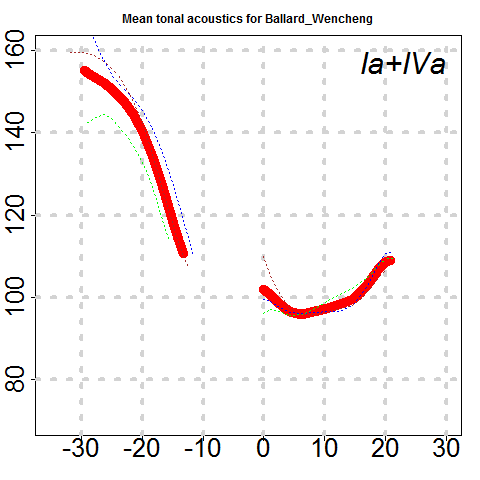
|
中学 middle school 单独 single 生活 work 
|
|
T1= lower-mid level (Ib/Yangping 陽平) |
田鸡 frog 农村 village 长衫 gown > |
羊毛 wool 银行 bank 皮球 rubber ball  |
门口 doorway 鞋底 sole 长短 length  |
行动 move 形像 image 文件 document  |
长凳 bench 文化 culture 脾气 mood  |
同事 workmate 程度 extent 长寿 long life  |
牛骨 oxbone 毛笔 writing brush 头发 hair  |
留学 study abroad 零食 snack 明白 understand  |
|
T1= high rise (IIa/Yinshang 陰上) |
点心 dimsum 火车 train 普通 ordinary  |
酒瓶 wine bottle 党员 party member 粉红 pink  |
口齿 enuncitation 小巧 exquisite 保险 insure  |
表演 perform 改造 reconstruct 处理 manage  |
板凳 stool 打算 intend 宝贝 precious  |
体面 face 子弹 bullet 本地 local 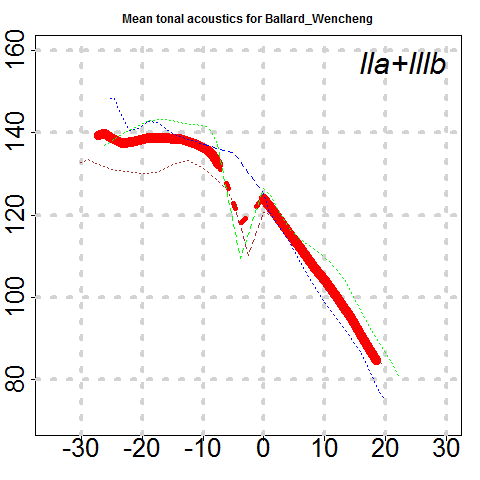 |
改革 reform 宝塔pagoda 本国 one's own country  |
酒席 banquet 普及 universal 主食 staple diet  |
|
T1= depressed upper-mid level (IIb/Yangshang 陽上) |
被窝 quilt 尾巴 tail 坐车 ride  |
市场 market 肚皮 stomach 象棋 chess  |
市长 mayor 老酒 booze 动手 start work  |
远近 distance 罪犯 criminal 旅社 hostel  |
眼镜 glasses 罪过 offence 动态 trend  |
社会 society 近视 near-sighted 部队 troops  |
负责 be responsible for 道德 moral 市尺 unit of length 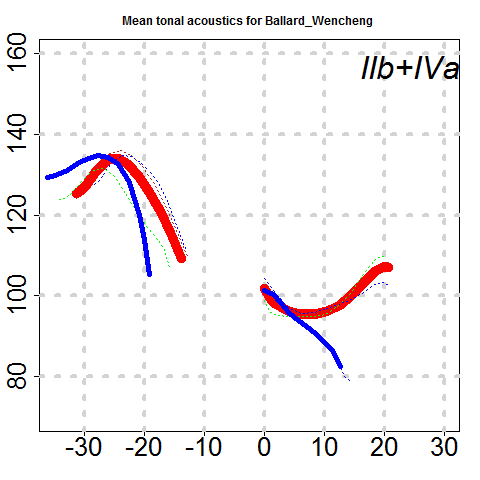 |
断绝 be cut off 动物 animal 静脉 vein 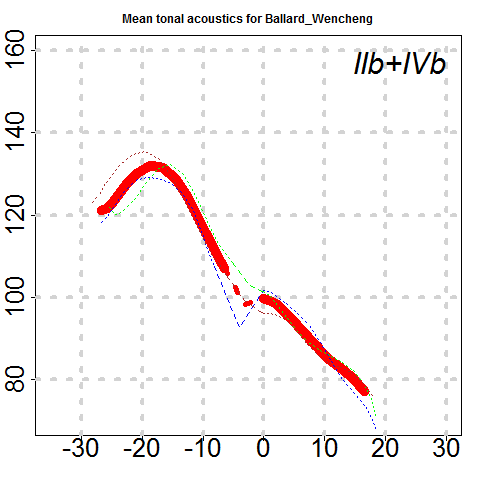 |
|
T1= lower-mid level (IIIa/Yinqu 陰去) |
快车 express train 四方 on all sides 背心 waistcoat  |
借条 receipt 报酬 pay 太平 peace  |
对比 contrast 跳板 springboard 报纸 newspaper  |
报社 newspaper office 靠近 near to 对象 sweetheart  |
世界 world 快信 express letter 故意 intentionally 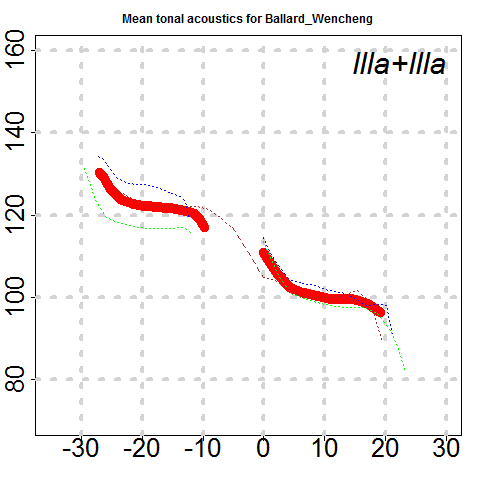 |
态度 attitude 见面 to meet 半路 in mid journey  |
爱国 patriotic 印刷 to print 快速 intentionally  |
性别 sex 半日 quite a while 势力 influence  |
|
T1= mid fall-rise (IIIb/Yangqu 陽去) |
树根 root 饭厅 cafeteria 地方 place 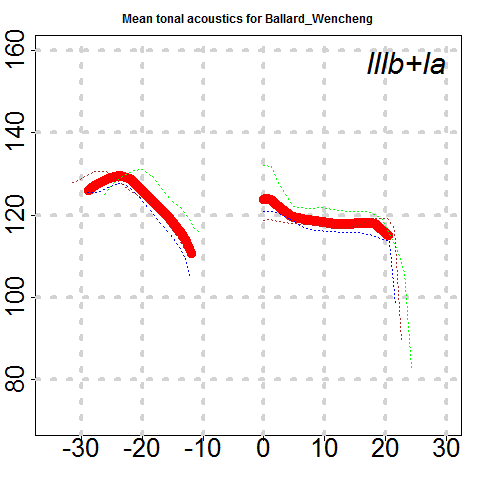 |
地球 earth 病人 patient 外行 layman  |
外省 other provinces 妄想 wishful thinking 大小 size  |
附近 nearby 运动 exercise 大米 rice  |
内战 civil war 旧货 junk 饭店 hotel  |
命令 order 外地 other places 寿命 lifespan  |
问答 questions & answers 字帖 copybook 办法 method  |
树叶 leaf 饭盒 lunchbox 大学 university  |
|
T1= low rise (IVa/Yinru 陰入) |
浙江 Zhejiang province 骨科 orthopedics 北风 north wind  |
足球 football 国旗 national flag 色盲 colourblind  |
作品 works 铁索 iron cable 出口 export  |
国语 national language 尺码 size 接近 move close to  |
百货 general merchanise 黑布 black cloth 脚气 beri-beri  |
革命 revolution 一定 definitely 发病 outbreak of illness  |
赤脚 barefoot 铁塔 pylon 发作 lose temper  |
骨肉 flesh & blood 吃力 tired 复杂 complicated  |
|
T1= low fall-rise (IVb/Yangru 陽入) |
月光 moon 别针 pin 实心 sincere  |
毒蛇 poisonous snake 月台 platform 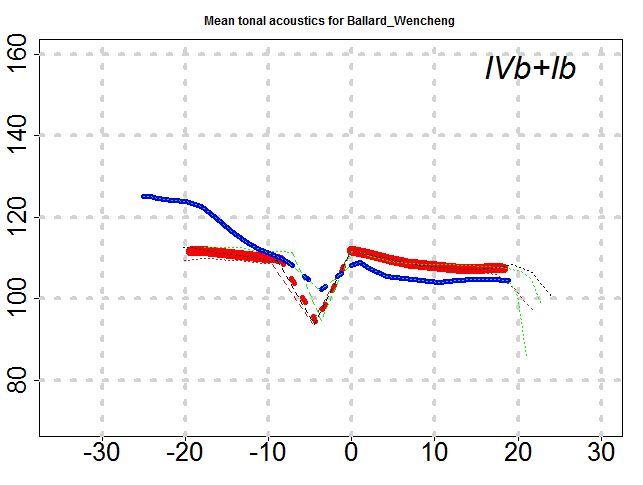 |
袜底 stocking sole 肉体 flesh 日本 Japan  |
物理 physics 活动 activity 白象 white elephant  |
热气 hot air 白布 calico 学费 tuition fees  |
服务 serve 实话 truth 热饭 hot food  |
蜡烛 candle 合作 cooperate 白铁 tin  |
学习 study 白药 medicinal powder 植物 plant 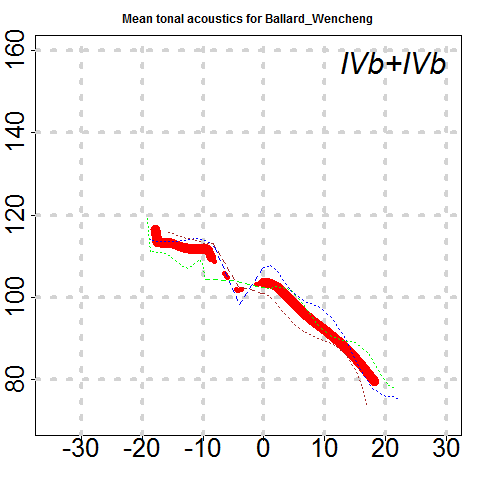 |